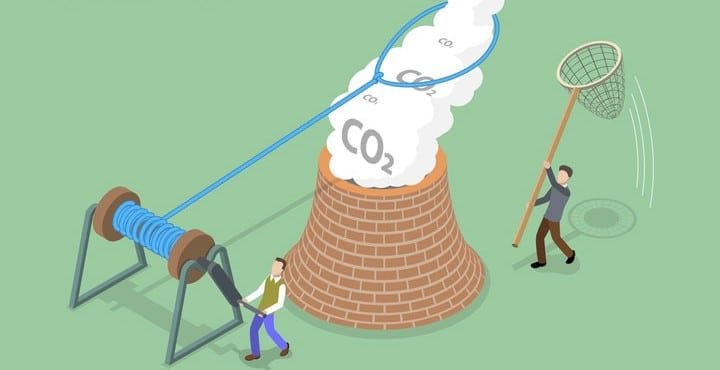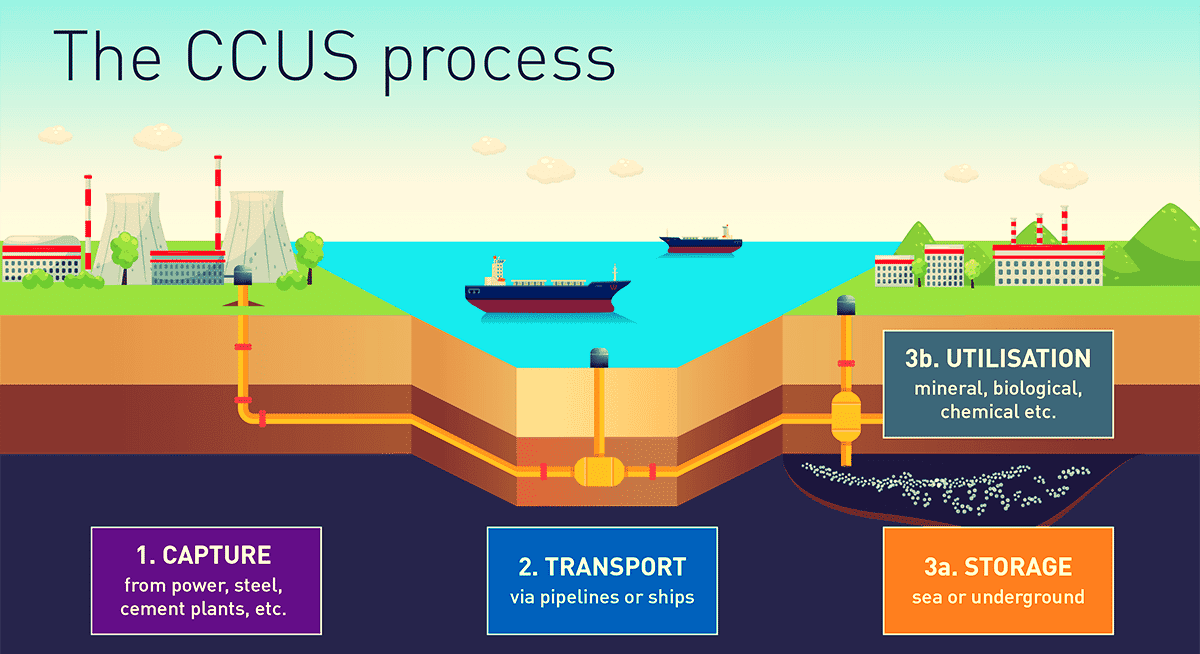Carbon capture and utilization technology is not only useful, but a necessary strategy to reduce atmospheric CO2 levels, and stall an increase in global temperatures in the near future. It works to remove atmospheric carbon dioxide, and either reuse it or permanently store it.
There are a myriad of technologies and methods to achieve this, ranging from direct air capture to forestry.
Carbon Sequestration Definition
Carbon capture, or carbon sequestration is the process which captures atmospheric carbon dioxide that is often released by emissions-heavy industries such as energy, construction, manufacturing and transport.
What happens after carbon dioxide is removed and then captured is called carbon utilization. It could be recycled and resold as an economically valuable product to industries. They would then convert this into end products to be sold, such as new materials or fuels.
Carbon fixation refers to the process in which the captured carbon dioxide is stored permanently in the earth, away from the atmosphere. The most common example of this in nature is the way plants convert atmospheric carbon dioxide into organic compounds (e.g. starch).
However, there are also emerging artificial carbon fixation technologies, such as the Orca carbon capture project. The plant pumps water and the captured carbon dioxide deep underground, where it will be permanently stored in rocks.
Collectively, all these processes are known as Carbon Capture, Utilization and Storage (CCUS).
Why is Carbon Capture, Utilization and Storage Critical Right Now?
Carbon capture, utilization and storage technology has been around for a really long time. However, interest in this area has increased exponentially in the past few years, due to the urgent climate targets that need to be met in coming years.
During the Paris Agreement and COP27, the consensus was that time is running out to tackle climate change without drastic changes in the coming years. The agreement was to limit the increase in average global temperatures to 2C and ideally, to 1.5C with respect to pre-industrial levels. An increase above these values would lead to irreversible damage to the planet.
In order to achieve this, the world would need to remove 1 billion tons of CO2 by 2025. While carbon negative renewable energy sources and planting trees can remove CO2 from the atmosphere, they are not sufficient to meet these climate targets. This is where the significant need for carbon capture and storage technology lies.
The Basic Steps of Carbon Capture, Utilization and Storage
In CCUS, there are four main steps involved:
- Sequestering CO2 at stationary sources such as power plants and industrial sites.
- Transporting the captured CO2 to storage sites (this involves compressing or liquefying the gas)
- Utilizing the captured carbon in various applications (e.g. carbonated beverages, gas injection for enhanced oil recovery)
- Permanently storing the CO2
In this article, we are mainly focusing on the first step, which is carbon capture or carbon sequestration.
Carbon Capture Methods
There are four main categories to which carbon capture methods belong to:
-
Pre-combustion carbon capture methods
This process removes carbon dioxide before the fossil fuels are burned. In this process, the fossil fuel undergoes a gasification process which turns it into a mixture of hydrogen and CO2. The hydrogen can be burned as a ‘clean’ fuel which does not produce CO2 as a waste product.
The CO2 captured can then be compressed, transported and stored for other industrial uses. This method is one of the ways of producing ‘blue’ hydrogen fuel.
Since the CO2 produced in pre-combustion carbon capture methods is higher in concentration, CO2 removal is easier and more efficient compared to post-combustion carbon capture. However, the capital costs related to gasification are quite expensive, especially if it is retrofitted into existing facilities instead of new ones.
-
Post-combustion carbon capture methods
Post-combustion carbon capture and utilization methods remove carbon dioxide gas after the fuel undergoes combustion. It is the most widely used across industries for carbon capture. This is typically done at the exhaust where CO2 is emitted. It uses specially designed filters or liquid solvents to separate the CO2 from the exhaust stream.
The first stage will be the absorption phase, where the solvent absorbs the CO2. The second phase will be the ‘desorption’ phase, where a change in temperature will cause the CO2 to be released from the solvent, and thereby separating the CO2.
Another example of a post-combustion carbon capture technology in development is using lime to remove CO2. The byproduct will be limestone, which can be heated to separate the CO2.
-
Oxyfuel combustion methods
Oxyfuel combustion processes use pure oxygen instead of air to burn fuel. This will eliminate other impurities such as sulfur dioxide. The byproduct in this case would then only be water vapor and CO2 gas, which can easily be separated.
-
Direct Air Capture
Direct Air Capture (DAC) is another novel carbon capture method. It removes CO2 from ambient air instead of only at stationary points of CO2 emission such as power plants.
The difference here is that with DAC, even CO2 emitted in the past can be removed. This would allow more CO2 to be removed from the atmosphere, reducing the overall CO2 levels in the air.
With post-combustion carbon capture, you are only removing the CO2 that is being emitted at that time. Hence, it prevents a further increase in CO2 levels.
Due to the urgency of climate action that needs to be taken, DAC is increasingly gaining interest. One of the leading carbon sequestration companies in this area is Swiss-based Climeworks. It has launched the world’s largest direct air carbon capture facility in Iceland, called the Orca carbon capture project.
The carbon capture plant would have an annual capacity to capture 4,000 tons of CO2.
The Future of Carbon Capture
With more development of such carbon capture plants, the goal is to lower the cost of carbon capture and sequestration. One of the biggest hurdles in the large-scale implementation of carbon capture and storage technology is the cost.
Since emitting carbon is cheap, there is little economic incentive to employ carbon capture technology on an industrial scale. However, things are improving, with more interest from investors, governments and scientists in recent years.


